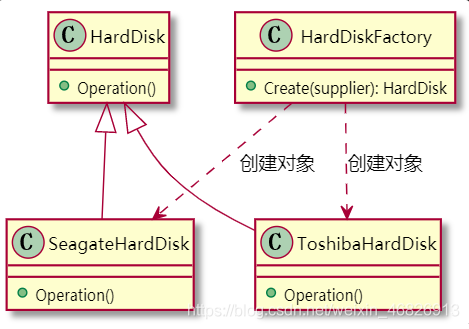点击蓝字

关注我们
1、简介
简单工厂方法定义一个用于创建对象的类,该类接受一个参数,通过参数决定创建不同的对象。
GOF并没有把简单工厂方法定义为23种设计模式之一,可以认为简单工厂方法是工厂方法的简化形式。
为了体现简单工厂方法和工厂方法的区别和联系,此处把简单工厂方法先单独讲一下。
2、模拟场景
假设你要生产电脑,电脑由硬盘、内存条、CPU、主板的部件组成。你为了保证供应链可靠,每种部件都选择了至少两家供应商。比如:
硬盘供应商 seagate、Toshiba
内存条供应商 SAMSUNG、Crucial
CPU供应商 intel、AMD
主板供应商 intel、AMD
此处列出多个部件是为了后面讲解工厂方法、抽象工厂方法时使用同一个模拟场景。本章讲简单工厂方法暂时不需要涉及这么多部件,所以仅以硬盘这一个部件为例进行讲解。
3、实现的思路
硬盘就是要创建的对象(即:产品)。为了让不同供应商提供的硬盘可以通用,要定义一个硬盘产品类,并让不同供应商的硬盘都继承硬盘产品类的接口。
还需要定义一个创建硬盘对象的类(即:工厂)。工厂类根据参数决定创建哪家供应商的硬盘对象。
4、实现硬盘对象创建
参与者:
(1)Product: HardDisk 定义硬盘对象的接口
(2)Concrete Product: SeagateHardDisk, ToshibaHardDisk 实现不同供应商的硬盘
(3)SimpleFactory: HardDiskFactory 根据参数,创建不同供应商的硬盘对象
UML:

HardDisk代码示例:
hard_disk.h:
#ifndef HARD_DISK_H
#define HARD_DISK_Hstruct HardDisk {void (*Operation)(struct HardDisk *this);
};#endifSeagateHardDisk代码示例:
seagate_hard_disk.h:
#ifndef SEAGATE_HARD_DISK_H
#define SEAGATE_HARD_DISK_H#include "hard_disk.h"struct SeagateHardDisk {struct HardDisk hardDisk;
};// 构造函数
void SeagateHardDisk(struct SeagateHardDisk *this);// 析构函数
void _SeagateHardDisk(struct SeagateHardDisk *this);#endifseagate_hard_disk.c:
#include "seagate_hard_disk.h"
#include "stdio.h"void SeagateOperation(struct SeagateHardDisk *this)
{printf("这是 Seagate 硬盘\n");
}void SeagateHardDisk(struct SeagateHardDisk *this)
{this->hardDisk.Operation = (void(*)(struct HardDisk *))SeagateOperation;
}void _SeagateHardDisk(struct SeagateHardDisk *this)
{this->hardDisk.Operation = NULL;
}ToshibaHardDisk代码示例:
toshiba_hard_disk.h:
#ifndef TOSHIBA_HARD_DISK_H
#define TOSHIBA_HARD_DISK_H#include "hard_disk.h"struct ToshibaHardDisk {struct HardDisk hardDisk;
};// 构造函数
void ToshibaHardDisk(struct ToshibaHardDisk *this);// 析构函数
void _ToshibaHardDisk(struct ToshibaHardDisk *this);#endiftoshiba_hard_disk.c:
#include "toshiba_hard_disk.h"
#include "stdio.h"void ToshibaOperation(struct ToshibaHardDisk *this)
{printf("这是 Toshiba 硬盘\n");
}void ToshibaHardDisk(struct ToshibaHardDisk *this)
{this->hardDisk.Operation = (void(*)(struct HardDisk *))ToshibaOperation;
}void _ToshibaHardDisk(struct ToshibaHardDisk *this)
{this->hardDisk.Operation = NULL;
}HardDiskFactory代码示例:
hard_disk_factory.h:
#ifndef HARD_DISK_FACTORY_H
#define HARD_DISK_FACTORY_H#include "hard_disk.h"enum HARD_DISK_SUPPLIER_E {HARD_DISK_SUPPLIER_SEAGATE,HARD_DISK_SUPPLIER_TOSHIBA
};struct HardDiskFactory {struct HardDisk* (*Create)(struct HardDiskFactory *this, enum HARD_DISK_SUPPLIER_E supplier);void (*Destroy)(struct HardDiskFactory *this, struct HardDisk* hardDisk);
};// 构造函数
void HardDiskFactory(struct HardDiskFactory *this);// 析构函数
void _HardDiskFactory(struct HardDiskFactory *this);#endifhard_disk_factory.c:
#include "hard_disk_factory.h"
#include "seagate_hard_disk.h"
#include "toshiba_hard_disk.h"
#include "stdio.h"
#include "stdlib.h"struct HardDisk *Create(struct HardDiskFactory *this, enum HARD_DISK_SUPPLIER_E supplier)
{switch (supplier) {case HARD_DISK_SUPPLIER_SEAGATE:{struct SeagateHardDisk *seagateHardDisk = NULL;if ((seagateHardDisk = malloc(sizeof(struct SeagateHardDisk))) == NULL) {printf("fail in malloc\n");return NULL;}SeagateHardDisk(seagateHardDisk);return (struct HardDisk *)seagateHardDisk;}case HARD_DISK_SUPPLIER_TOSHIBA:{struct ToshibaHardDisk *toshibaHardDisk = NULL;if ((toshibaHardDisk = malloc(sizeof(struct ToshibaHardDisk))) == NULL) {printf("fail in malloc\n");return NULL;}ToshibaHardDisk(toshibaHardDisk);return (struct HardDisk *)toshibaHardDisk;}default:printf("未知的供应商\n");return NULL;}
}void Destroy(struct HardDiskFactory *this, struct HardDisk* hardDisk)
{if (hardDisk != NULL) {free(hardDisk);}
}// 构造函数
void HardDiskFactory(struct HardDiskFactory *this)
{this->Create = Create;this->Destroy = Destroy;
}// 析构函数
void _HardDiskFactory(struct HardDiskFactory *this)
{this->Create = NULL;this->Destroy = NULL;
}客户端代码示例:
#include "hard_disk.h"
#include "hard_disk_factory.h"
#include "stddef.h"void main()
{struct HardDisk *hardDisk = NULL;struct HardDiskFactory hardDiskFactory;HardDiskFactory(&hardDiskFactory);// 创建 seagate 硬盘对象hardDisk = hardDiskFactory.Create(&hardDiskFactory, HARD_DISK_SUPPLIER_SEAGATE);// 使用 seagate 硬盘对象hardDisk->Operation(hardDisk); // 销毁 seagate 硬盘对象hardDiskFactory.Destroy(&hardDiskFactory, hardDisk); // 创建 toshiba 硬盘对象hardDisk = hardDiskFactory.Create(&hardDiskFactory, HARD_DISK_SUPPLIER_TOSHIBA);// 使用 seagate 硬盘对象hardDisk->Operation(hardDisk);// 销毁 toshiba 硬盘对象hardDiskFactory.Destroy(&hardDiskFactory, hardDisk); _HardDiskFactory(&hardDiskFactory);
}客户端显示示例:
./hard_disk
这是 Seagate 硬盘
这是 Toshiba 硬盘*声明:本文于网络整理,版权归原作者所有,如来源信息有误或侵犯权益,请联系我们删除或授权事宜。


戳“阅读原文”我们一起进步




和ctype_digit()之间有区别吗?)






![mysql不同版本会覆盖吗,[mysql不同版本数据库同步]mysql数据库主从同步,master和slave上的mysql必须版本一样吗,如果不一样会有什么结果?...](http://pic.xiahunao.cn/mysql不同版本会覆盖吗,[mysql不同版本数据库同步]mysql数据库主从同步,master和slave上的mysql必须版本一样吗,如果不一样会有什么结果?...)







